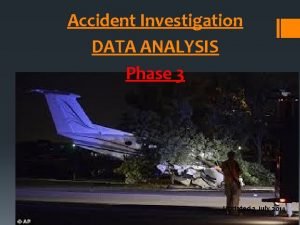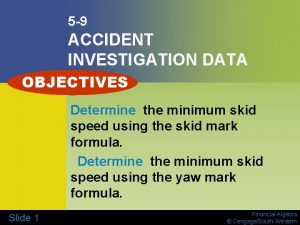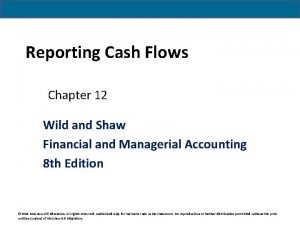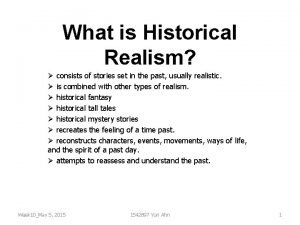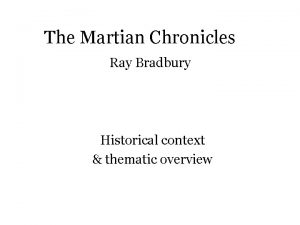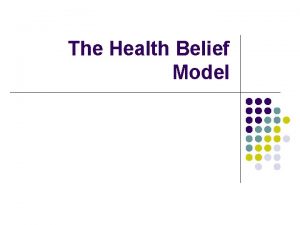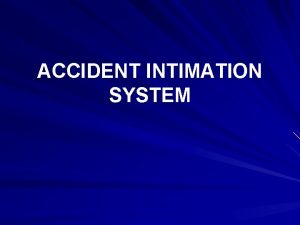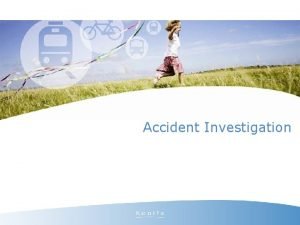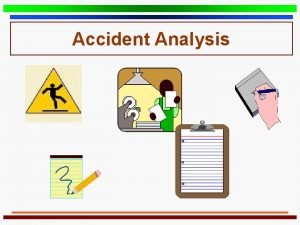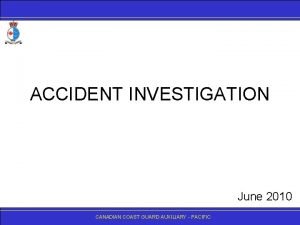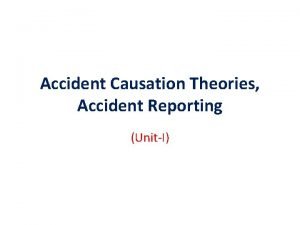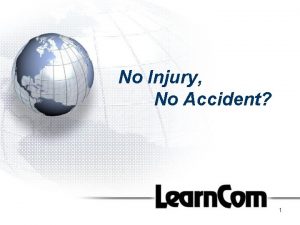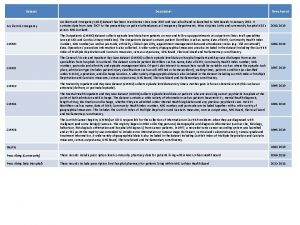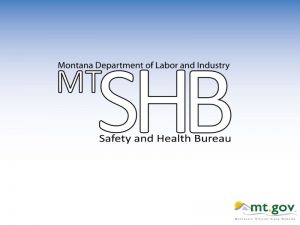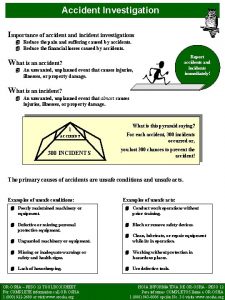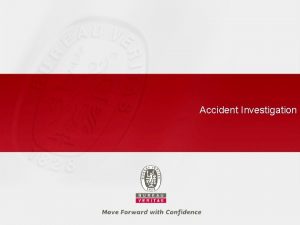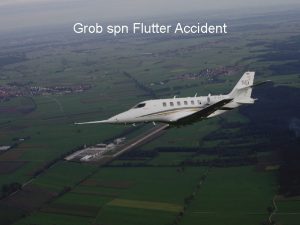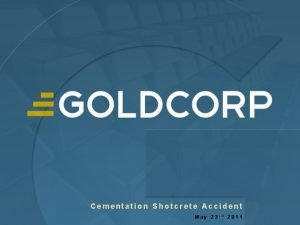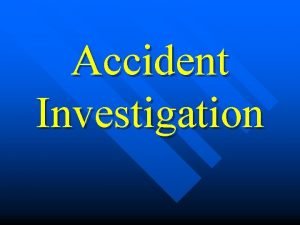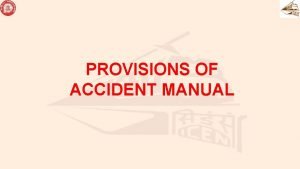Analysis of Historical Accident Data to Determine Accident





















- Slides: 21

Analysis of Historical Accident Data to Determine Accident Prone Locations and Cause of Accidents Presenter- Arshardh Ifthikar

Domain ▲ 1 Billion In 2011

Problem � Nearly 1. 3 million people die in road crashes each year, on average 3, 287 deaths a day. � An additional 20 -50 million are injured or disabled. � More than half of all road traffic deaths occur among young adults ages 15 -44. � Road traffic crashes rank as the 9 th leading cause of death and account for 2. 2% of all deaths globally. � Road crashes are the leading cause of death among young people ages 15 -29, and the second leading cause of death worldwide among young people ages 5 -14. � Each year nearly 400, 000 people under 25 die on the world's roads, on average over 1, 000 a day. � Over 90% of all road fatalities occur in low and middle-income countries, which have less than half of the world's vehicles. � Road crashes cost USD $518 billion globally, costing individual countries from 1 -2% of their annual GDP. � Road crashes cost low and middle-income countries USD $65 billion annually, exceeding the total amount received in developmental assistance.

Determining the Road Defects Impact on Accident Severity Esmaeili, A. , Khalili, M. , and Pakgohar, A � Lack of caution at accident-prone locations is also a major cause of accidents. � For an example, if a specific part of a road has less visibility, and as a result, frequent accidents occur, the drivers may not anticipate such a threat unless the person is from that specific area.

Motivation 34% 36% EUROPE IRAN OF TOTAL ACCIDENTS ARE REPORTED DUE TO UNSAFE ROADS

A mechanism for Perspective Analysis of Traffic Accident using Data Mining Techniques. S. Krishnaveni and Dr. M. Hemalatha It deals with comparing classification models to predict the severity of the injury that occurred during a traffic accident. The author has compared Naive Bayesian classifier, Ada. Boost. M 1 Meta classifier, PART Rule classifier, J 48 Decision Tree classifier and Random Forest Tree classifier for classifying the type of injury severity of various traffic accidents. The final result shows that the Random Forest outperforms other algorithms.

A review of The Effect of Traffic and Weather Characteristics on Road Safety. Yannis T. H. This research attempts to identify the relationship between traffic patterns and weather condition on the accident rate. The research determines the traffic flow seems to have a non-linear relationship with accident rates, even though some studies suggest a linear relationship with accidents. Pertaining to the relationship with the weather, the impact of precipitation is very steady and leads for the most part to expanded accident recurrence. The author also suggests that the increasing use of real-time data not only makes easier to identify the safety impact of traffic and weather characteristics, but most importantly makes possible the identification of their combined effect which may address several of the research gaps identified in the research conducted.

Analysis of accidents on small portion NH-3 Indore to Dhamnod. K. Meshram and H. S. Goliya The data for analysis is collected for the period from 2009 to September 2011. It has been identified that more accidents occurred in Manpur region by faulty road geometry. The pattern of accidents occurred in urban areas (Indore) has contributed more than 35 % of the total accidents in each year. The research done states this may be due to high speeds and more vehicular traffic. In the considered study area, the frequency of accidents were two fatal accidents and six minor accidents per week. A higher number of accidents are said to be observed from 6 pm to 8 pm duration because in that time more buses travel connecting villages and the city.

Data Analytics on Accident Data for Smarter Cities and Safer Lives Abhinav Shikhar, Naveen JS, Sowmya B J, KG Srinivas The focus is laid on the application of data analytics to predict and reduce the impact of the accidents and uncover the relevant trends by training the system with the past data using decision tree methodology. The major causes leading to the accidents are identified analysed using some of the relevant attributes such as alcohol consumption, hit-and-run cases etc.

Prediction of the Cause of Accident and Accident Prone Location on Roads Using Data Mining Techniques Kaur, M. G. , & Harpreet Kaur, E predicting the probability of accidents by estimating the severity of accidents based on the type of accident and type of spot. The type of spots considered are straight roads, cross-intersection, r-intersection, y-intersection, toll plaza, narrow bridge and near the curve. The frequency of traffic collision of roads is analysed using correlation analysis and exploratory visualization techniques. The abovementioned paper concludes that the accidents on State Highways occur on Straight roads and on Ordinary District Roads, the accidents can occur on other type of spots such as Cross-Intersections, R-intersections and Straight roads but majorly on Cross- intersections. Also, the main type of accident that occurs is Head on collisions on both Highways and Ordinary District Roads.

Proposed Work

Data Set � Date � Road Type � Day � Speed limit � Longitude � Junction Detail � Latitude � Junction Control � Accident Severity � Light Conditions � Number of Vehicles � Weather Conditions � Number of Casualties � Road Surface Conditions � Time � Special Conditions at Site

Clustering � DBSCAN (Density-Based Spatial Clustering of Applications with Noise) � K-Means � LCGM (Latent Class Growth Modelling) � BIRCH (Balanced Iterative Reducing and Clustering using Hierarchies) � CURE (Clustering Using REpresentatives)

Clustering Result

Cause Identification Column Names H(S) = − Σx∈X p(x) log 2 p(x) � H(S) is the entropy � p(x) is the number of successful cases � X is the set of all the events � x is one event out of those, used one at a time Entropy Two Most Common Items Day 1. 73154318 [(3, 7), (4, 5)] Accident Severity 0. 42932302 [(3, 22), (2, 4)] Number of Vehicles 0. 81015022 [(1, 15), (2, 10)] Time 2. 68465654 [(13, 3), (08, 3)] Light Conditions 0. 7126573 [(1, 15), (4, 11)] Weather Conditions 0. 35762716 [(1, 23), (2, 3)] Road Surface Conditions 0. 40294135 [(1, 31), (2, 5)] Special Conditions at Site 0 [(3, 26)] Carriageway Hazards 0 [(0, 26)]

Cause Identification Column Names Entropy Two Most Common Items Day 1. 73154318 [(3, 7), (4, 5)] Accident Severity 0. 42932302 [(3, 22), (2, 4)] Number of Vehicles 0. 81015022 [(1, 15), (2, 10)] Time 2. 68465654 [(13, 3), (08, 3)] Light Conditions 0. 7126573 [(1, 15), (4, 11)] Weather Conditions 0. 35762716 [(1, 23), (2, 3)] Road Surface Conditions 0. 40294135 [(1, 31), (2, 5)] Special Conditions at Site 0 [(3, 26)] Carriageway Hazards 0 [(0, 26)] ▼ Road sign or Marking Defective or Obscured

Proposed System

Related Work Comparison Other systems, as mentioned in the related work, classify all accidents based on attributes such as, the type of road and the weather condition. But the proposed solution suggests a system where the accidents in each accident-prone location are classified separately on attributes such as road surface condition and weather condition, in order to determine the cause of accidents at accidentprone locations. This gives the resulting data more value and interpretability.

Conclusion This study discusses different attempts made to determine the causes of accidents using different algorithms and datasets with attributes such as weather, type of intersection and road geometry. It also proposes a system which clusters accidents based on its location given via latitudes and longitudes and subsequently determines the cause of an accident based on historical data. These data can be used by authorities to rectify issues in roads and also for drivers to be vigilant on accident-prone areas.

Future Work � The proposed system is still at the concept stage, and it needs to be implemented and evaluated for its efficiency. � Driverless cars were an emerging field in the past few years, but it has become a reality by now. This system can be used for fully autonomous cars to take precautions at dangerous road sections. Fully autonomous cars can contribute to this system too once an accident takes place. Once such a system is introduced, it will help the community to build trust in fully autonomous cars, which is a challenge faced by autonomous car manufacturers

Thank You Very Much !
 What's history
What's history Accident investigation data analysis
Accident investigation data analysis Historical analysis
Historical analysis Follow through day stocks
Follow through day stocks 5-9 accident investigation data answers
5-9 accident investigation data answers Wild cash flow
Wild cash flow Content analysis of secondary data
Content analysis of secondary data Data collection procedure and data analysis
Data collection procedure and data analysis Data preparation and basic data analysis
Data preparation and basic data analysis Data acquisition and data analysis
Data acquisition and data analysis Kronos workforce central 8
Kronos workforce central 8 Christine counsell 5 rs
Christine counsell 5 rs Historical realism
Historical realism Historical institutionalism
Historical institutionalism What is genre
What is genre Biographical approach to literary criticism
Biographical approach to literary criticism Background information on to kill a mockingbird
Background information on to kill a mockingbird The veldt similes
The veldt similes Ray bradbury context
Ray bradbury context Historical biography example
Historical biography example Hanukkah historical background
Hanukkah historical background Historical origins of the health belief model
Historical origins of the health belief model

